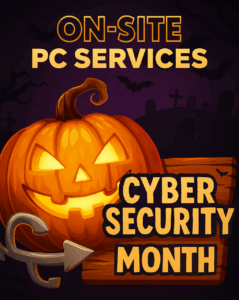🎃 Don’t Get Tricked by Cyber Ghouls — Lessons from the Salesforce Data Scare
Published: October 2025 | Security Awareness Month
This Halloween season, the scariest stories aren’t about haunted houses — they’re about data breaches and human error. In early October, a hacker collective claimed to have stolen nearly one billion Salesforce records. While Salesforce has stated that its core systems weren’t breached, the event is a chilling reminder of how easily cybercriminals exploit human trust.
As we celebrate Security Awareness Month, it’s the perfect time to turn this real-world “data fright” into an opportunity: to train our people, tighten our processes, and keep the monsters out of our networks.
🕸 What Happened
- A hacker group known as Scattered LAPSUS$ Hunters claimed to have stolen data linked to Salesforce customers.
- They reportedly used vishing — phone-based social engineering — to trick employees into granting access.
- Once inside, attackers allegedly exploited a legitimate Salesforce data tool to harvest information.
- Salesforce said its systems remain secure but confirmed investigations into client-related access points.
- The real culprit? Human vulnerability — not faulty technology.
💀 Why This Should Give Businesses Goosebumps
Even if you don’t use Salesforce, this attack reveals a larger truth: cybercriminals prey on trust. Here’s what makes this case so haunting:- The call is coming from inside the office. Vishing and phishing don’t rely on malware — they rely on your employees answering the wrong call or clicking the wrong link.
- Trusted vendors aren’t invincible. Even the biggest platforms can become stepping stones for attackers.
- Admin accounts are the ultimate treasure chest. Once breached, attackers can drain massive amounts of data undetected.
- Fear fades — habits don’t. Awareness must become culture, not just a one-month campaign.
🧙♂️ 4 Ways to Keep the Cyber Monsters Away
1️⃣ Strengthen Your Human Firewall
- Run phishing and vishing simulations to help your team recognize social engineering tricks.
- Use verification phrases before granting support or system access.
- Celebrate “catching” suspicious activity — make reporting a win, not a punishment.
2️⃣ Lock Down Admin Access
- Follow the principle of least privilege — give access only to those who truly need it.
- Enable multi-factor authentication (MFA) for every account with admin rights.
- Regularly review and revoke stale or unused credentials.
3️⃣ Watch Your Vendors — and Their Vendors
- Ask partners about their incident response and social engineering prevention protocols.
- Monitor integrations between your systems and theirs for unusual activity.
- Require vendors to notify you immediately if they suspect compromise.
4️⃣ Practice Your Incident Response Playbook
- Run tabletop exercises — simulate a data scare before one happens.
- Keep pre-approved communications ready for employees and customers.
- After any “near miss,” perform a post-mortem to strengthen defenses.
🦇 How OSPC Helps You Stay Protected
At On-Site PC Services (OSPC), we help businesses avoid these cybersecurity horrors with proactive protection and employee education. Our managed IT and cybersecurity services include:- Simulated phishing & vishing campaigns
- Security awareness training with interactive learning modules
- Zero Trust access management and endpoint protection
- Vendor risk and compliance assessments
- Incident response planning and communication templates
Tags: Security Awareness Month, Cybersecurity, Data Breach, Managed IT, OSPC, Salesforce Hashtags: #OnsitePC #ManagedIT #OSPC #CyberSecurityAwareness #DataProtection #HalloweenCyberSafety
